0 定义
深入 ChannelPipeline、ChannelHandler 和 EventLoop 后,如何将这些部分组织起来,成为可运行的应用程序?
引导(Bootstrapping)!引导一个应用程序是指对它进行配置,并使它运行起来的过程—尽管该过程的具体细节可能并不如它的定义那样简单,尤其是对于一个网络应用程序来说。
和它对应用程序体系架构的分层抽象一致,Netty处理引导的方式使你的【应用程序的逻辑或实现】和【网络层】相
隔离,而无论它是客户端还是服务器。所有的框架组件都将会在后台结合在一起并启用。引导是我们一直以来都在组装的完整拼图(Netty 的核心概念以及组件,也包括如何完整正确地组织并且运行一个 Netty 应用程序)中缺失的那一块。当你把它放到正确的位置上时,你的Netty应用程序就完整了。
1 Bootstrap 类
引导类的层次结构包括一个抽象父类和两个具体的引导子类:

相比于将具体的引导类分别看作用于服务器、客户端的引导,记住它们的本意是用来支撑不同的应用程序的功能的更有裨益,即:
-
服务器致力于使用一个父 Channel 接受来自客户端的连接,并创建子 Channel 用于它们之间的通信
-
而客户端将最可能只需要一个单独的、没有父 Channel 的 Channel 用于所有的网络交互
正如同我们将看到的,这也适用于无连接的传输协议,如 UDP,因为它们并不是每个连接都需要一个单独的 Channel
客户端和服务器两种应用程序类型之间通用的引导步骤由 AbstractBootstrap 处理,而特定于客户端或服务器的引导步骤则分别由 Bootstrap 或 ServerBootstrap 处理。
接下来将详细地探讨这两个类,首先从不那么复杂的 Bootstrap 类开始。
1.1 为何引导类是 Cloneable
有时可能需要创建多个类似或完全相同配置的Channel。为支持这种模式而又无需为每个 Channel 都创建并配置一个新的引导类实例, AbstractBootstrap 被标记为 Cloneable。在一个已配置完成的引导类实例上调用clone()方法将返回另一个可立即使用的引导类实例。
这种方式只会创建引导类实例的EventLoopGroup的浅拷贝,所以,【被浅拷贝的 EventLoopGroup】将在所有克隆的Channel实例之间共享。这能接受,因为通常这些克隆的Channel的生命周期都很短暂,一个典型场景:创建一个Channel以进行一次HTTP请求。
AbstractBootstrap 类的完整声明:
// 子类型 B 是其父类型的一个类型参数,因此可以返回到运行时实例的引用以支持方法的链式调用(流式语法)
public abstract class AbstractBootstrap<B extends AbstractBootstrap<B, C>, C extends Channel> implements Cloneable {
其子类的声明:
public class Bootstrap extends AbstractBootstrap<Bootstrap, Channel> {
}
public class ServerBootstrap extends AbstractBootstrap<ServerBootstrap, ServerChannel> {
}
2 引导客户端和无连接协议
Bootstrap类被用于客户端或使用了无连接协议的应用程序。表8-1很多继承自AbstractBootstrap:
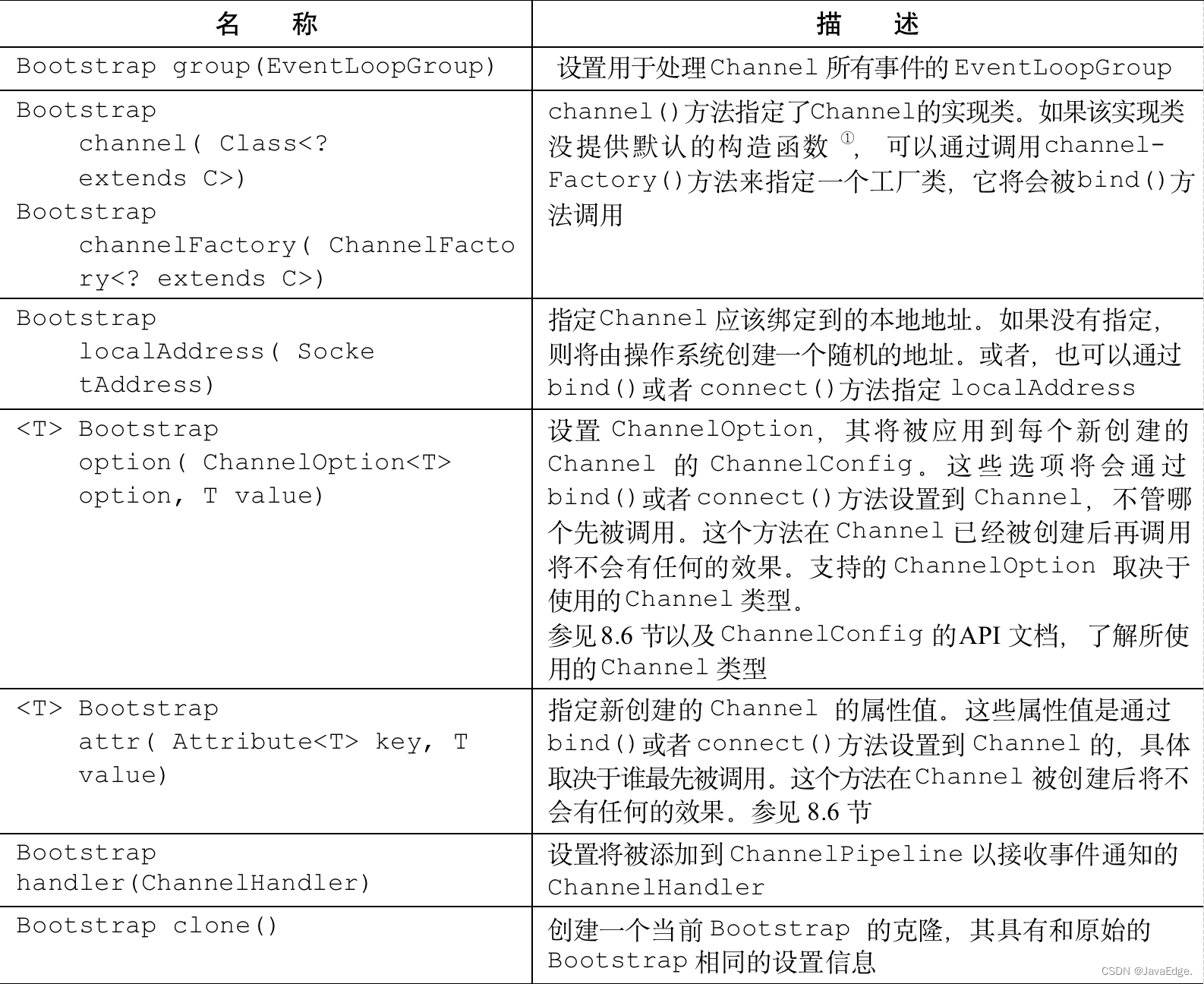

2.1 引导客户端
Bootstrap 类负责为客户端和使用无连接协议的应用程序创建 Channel,如图 8-2:
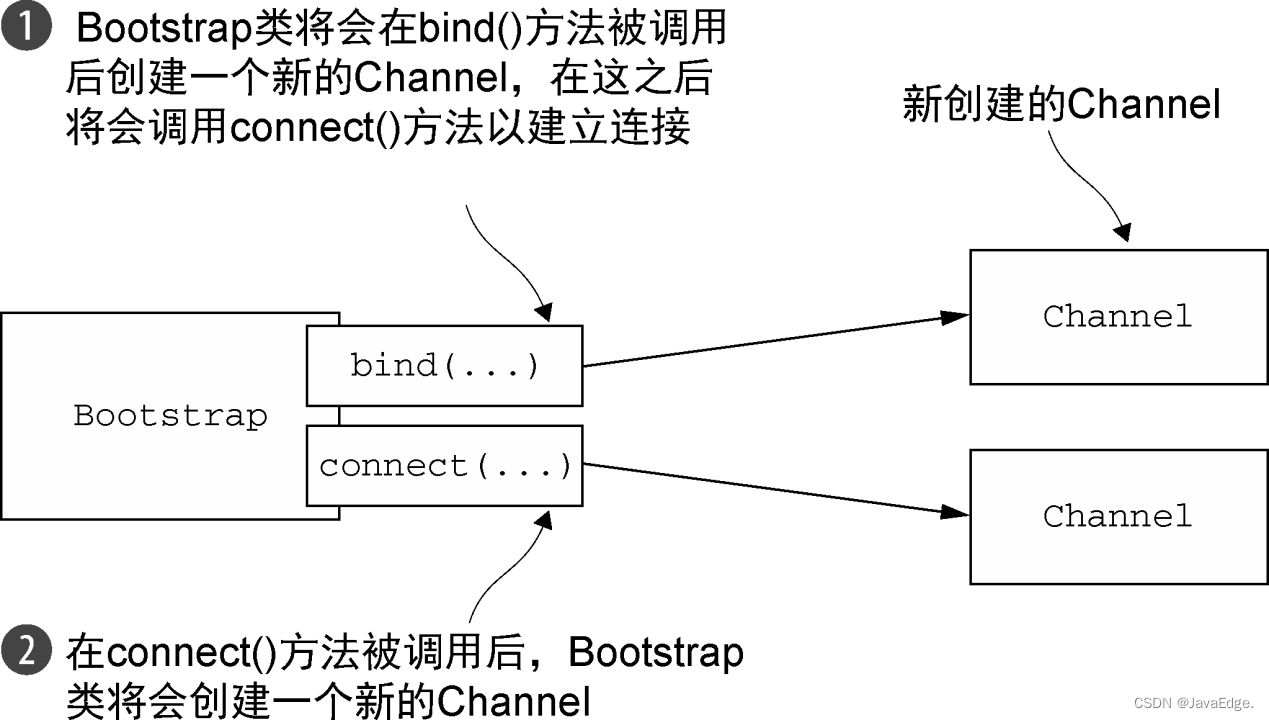
代码清单 8-1 引导了一个使用 NIO TCP 传输的客户端。
代码清单 8-1:引导一个客户端
EventLoopGroup group = new NioEventLoopGroup();
// 创建一个Bootstrap类的实例,以创建和连接新的客户端
Channel
Bootstrap bootstrap = new Bootstrap();
/**
* 使用流式语法;这些方法(除了connect()方法)将通过每次方法调用所返回的对 Bootstrap 实例的引用
* 链接在一起。
*/
// 设置 EventLoopGroup,提供用于处理 Channel 事件的 EventLoop
bootstrap.group(group)
// 指定要使用的 Channel 实现
.channel(NioSocketChannel.class)
// 设置用于 Channel 事件和数据的ChannelInboundHandler
.handler(new SimpleChannelInboundHandler<ByteBuf>() {
@Override
protected void channelRead0(
ChannelHandlerContext channelHandlerContext,
ByteBuf byteBuf) throws Exception {
System.out.println("Received data");
}
});
// 连接到远程主机
ChannelFuture future = bootstrap.connect(new InetSocketAddress("www.JavaEdge.com", 80));
future.addListener(new ChannelFutureListener() {
@Override
public void operationComplete(ChannelFuture channelFuture) throws Exception {
if (channelFuture.isSuccess()) {
System.out.println("Connection established");
} else {
System.err.println("Connection attempt failed");
channelFuture.cause().printStackTrace();
}
}
});
2.2 Channel 和 EventLoopGroup 的兼容性
代码清单 8-2 所示目录清单来自 io.netty.channel 包。从包名及类名前缀可见,对 NIO 及 OIO 传输,都有相关EventLoopGroup 和 Channel 实现。
相互兼容的 EventLoopGroup 和 Channel:

必须保持这种兼容性,不能混用具有不同前缀的组件,如 NioEventLoopGroup 和 OioSocketChannel。代码清单 8-3 展示了试图这样做的一个例子
EventLoopGroup group = new NioEventLoopGroup();
// 创建一个新的 Bootstrap类的实例,以创建新的客户端Channel
Bootstrap bootstrap = new Bootstrap();
// 指定一个适用于 NIO 的 EventLoopGroup 实现
bootstrap.group(group)
// 指定一个适用于OIO 的 Channel 实现类
.channel(OioSocketChannel.class)
// 设置一个用于处理 Channel的 I/O 事件和数据的ChannelInboundHandler
.handler(new SimpleChannelInboundHandler<ByteBuf>() {
@Override
protected void channelRead0(ChannelHandlerContext channelHandlerContext, ByteBuf byteBuf)
throws Exception {
System.out.println("Received data");
}
});
// 尝试连接到远程节点
ChannelFuture future = bootstrap.connect(new InetSocketAddress("www.JavaEdge.com", 80));
future.syncUninterruptibly();
这段代码将会导致 IllegalStateException,因为它混用了不兼容的传输
Exception in thread "main" java.lang.IllegalStateException: incompatible event loop type: io.netty.channel.nio.NioEventLoop
at io.netty.channel.AbstractChannel$AbstractUnsafe.register(AbstractChannel.java:462)
IllegalStateException
引导的过程中,在调用 bind()或 connect()前,必须调用以下方法来设置所需的组件:
- group()
- channel()或者 channelFactory()
- handler()
若不这样做,将导致 IllegalStateException。对 handler()方法的调用尤其重要,因为它需要配置好 ChannelPipeline。
3 引导服务器
从 ServerBootstrap API 概要视图开始对服务器引导过程的概述。然后,探讨引导服务器过程中所涉及的几个步骤及几个相关的主题,包含从一个 ServerChannel 的子 Channel 中引导一个客户端这样的特殊情况。
3.1 ServerBootstrap 类
表 8-2 列出了 ServerBootstrap 类的方法:
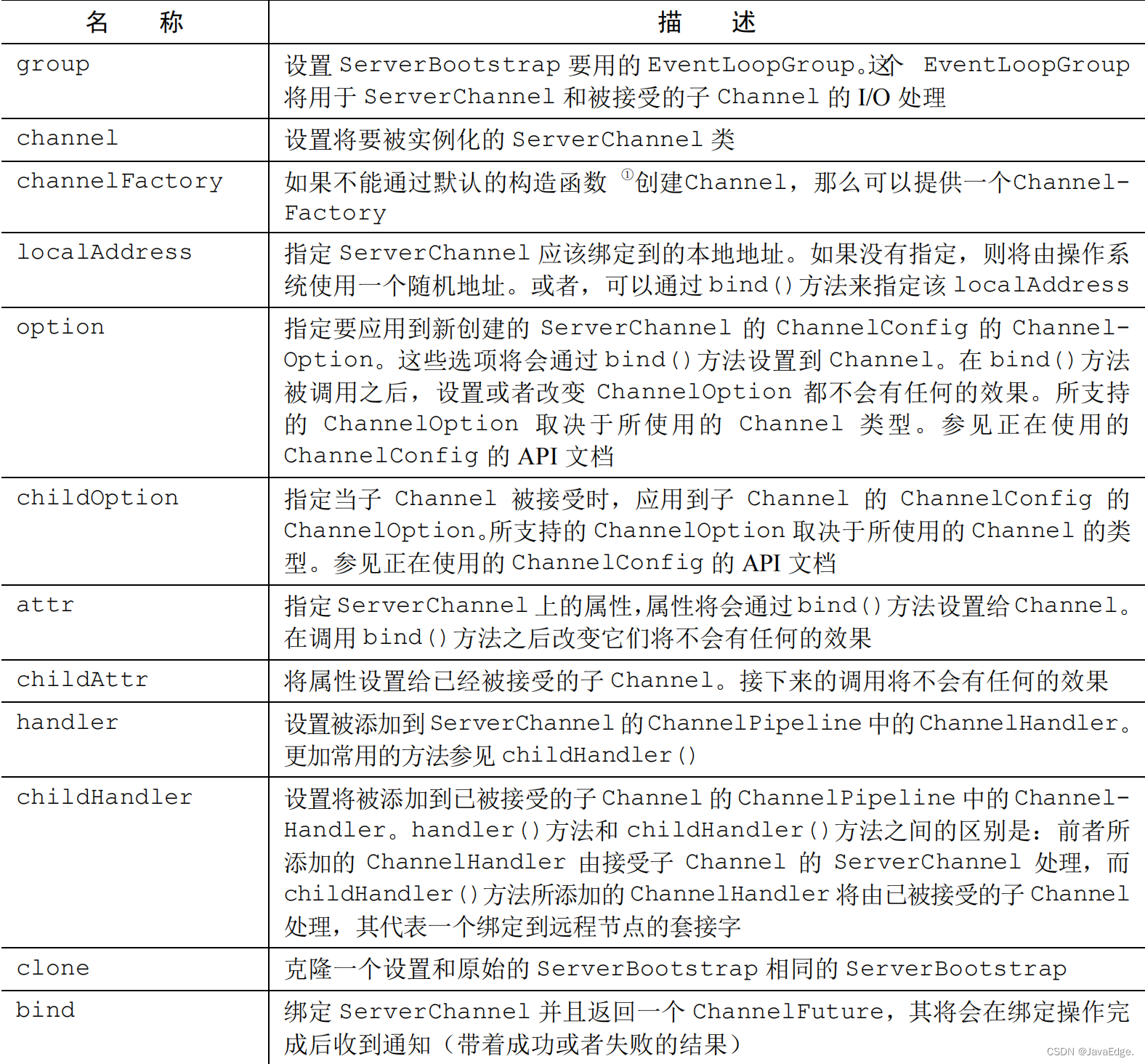
3.2 引导服务器
表 8-2 中列出一些表 8-1 不存在的方法:childHandler()、childAttr()和 childOption()。这些调用支持特别用于服务器应用程序的操作。
ServerChannel 的实现负责创建子 Channel,这些子 Channel 代表了已被接受的连接。因此,负责引导 ServerChannel 的 ServerBootstrap 提供了这些方法,以简化将设置应用到已被接受的子 Channel 的 ChannelConfig 的任务。
图 8-3 展示 ServerBootstrap 在 bind()方法被调用时创建了一个 ServerChannel,并且该 ServerChannel 管理了多个子 Channel。
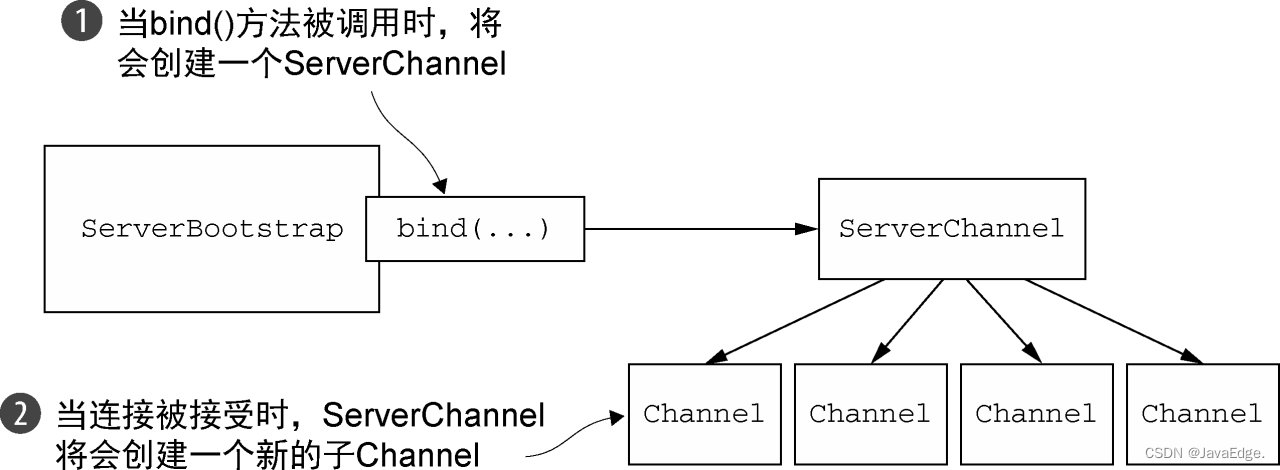
代码8-4 实现图 8-3 中所展示的服务器的引导过程:
package io.netty.example.cp8;
import io.netty.bootstrap.ServerBootstrap;
import io.netty.buffer.ByteBuf;
import io.netty.channel.ChannelFuture;
import io.netty.channel.ChannelFutureListener;
import io.netty.channel.ChannelHandlerContext;
import io.netty.channel.SimpleChannelInboundHandler;
import io.netty.channel.nio.NioEventLoopGroup;
import io.netty.channel.socket.nio.NioServerSocketChannel;
import java.net.InetSocketAddress;
/**
* 代码清单 8-4 引导服务器
*
* @author JavaEdge
* @date 2023/5/20
*/
public class Demo84 {
public static void main(String[] args) {
NioEventLoopGroup group = new NioEventLoopGroup();
// 创建 ServerBootstrap
ServerBootstrap bootstrap = new ServerBootstrap();
// 设置 EventLoopGroup,其提供了用于处理Channel 事件的EventLoop
bootstrap.group(group)
// 指定要使用的 Channel 实现
.channel(NioServerSocketChannel.class)
// 设置用于处理已被接受的子Channel的I/O及数据的 ChannelInboundHandler
.childHandler(new SimpleChannelInboundHandler<ByteBuf>() {
@Override
protected void channelRead0(ChannelHandlerContext ctx, ByteBuf byteBuf) throws Exception {
System.out.println("Received data");
}
});
// 通过配置好的ServerBootstrap的实例绑定该Channel
ChannelFuture future = bootstrap.bind(new InetSocketAddress(8080));
future.addListener(new ChannelFutureListener() {
@Override
public void operationComplete(ChannelFuture channelFuture) throws Exception {
if (channelFuture.isSuccess()) {
System.out.println("Server bound");
} else {
System.err.println("Bound attempt failed");
channelFuture.cause().printStackTrace();
}
}
});
}
}
4 从 Channel 引导客户端
服务器正在处理一个客户端请求,该请求需要它充当第三方系统的客户端。当一个应用程序(如一个代理服务器)必须要和现有的系统(如 Web 服务或数据库)集成时,就可能发生这种情况。此时,将需要从已被接受的子 Channel 中引导一个客户端 Channel。
可按 8.2.1 节中所描述的方式创建新的 Bootstrap 实例,但是这并不是最高效的解决方案,因为它要求你为每个新创建的客户端 Channel 定义另一个 EventLoop,会产生额外的线程,以及在已被接受的子 Channel 和客户端 Channel 之间交换数据时不可避免的上下文切换。
更好的解决方案
将已被接受的子 Channel 的 EventLoop 传递给 Bootstrap 的 group()方法来共享该 EventLoop。因为分配给 EventLoop 的所有 Channel 都使用同一线程,所以这避免了:
- 额外的线程创建
- 前面所提到的相关的上下文切换
该共享的解决方案图:
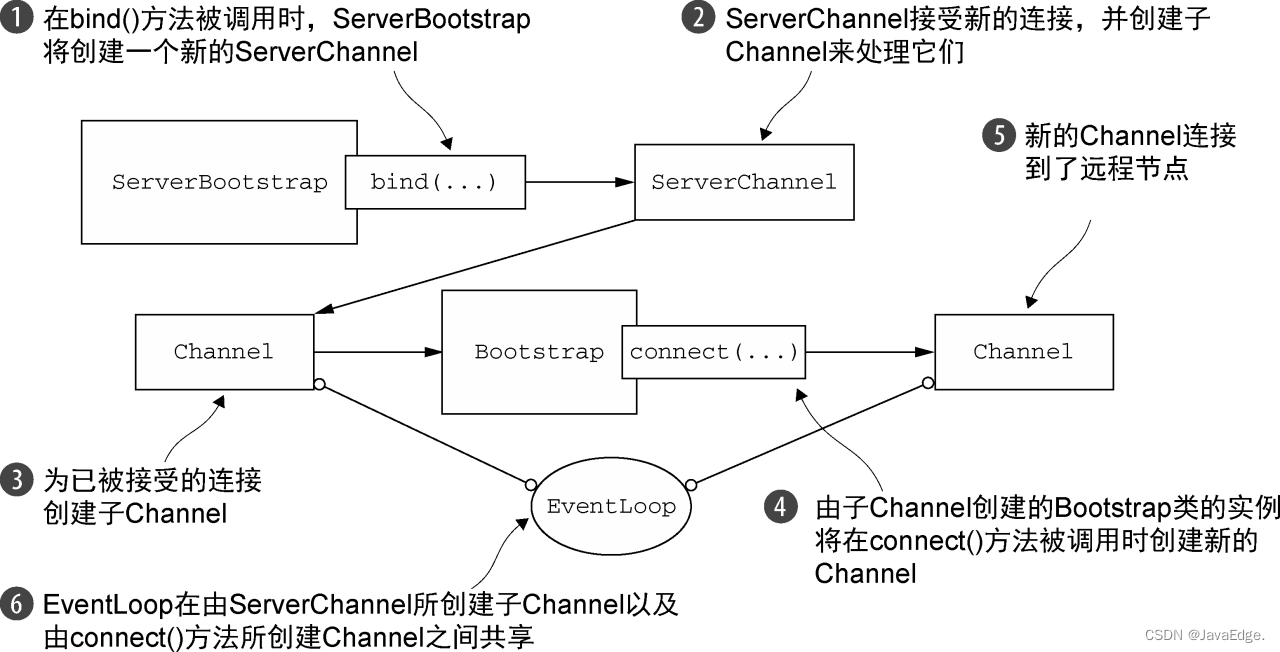
实现 EventLoop 共享涉及通过调用 group()方法来设置 EventLoop,如代码8-5:
package io.netty.example.cp8;
import io.netty.bootstrap.Bootstrap;
import io.netty.bootstrap.ServerBootstrap;
import io.netty.buffer.ByteBuf;
import io.netty.channel.ChannelFuture;
import io.netty.channel.ChannelFutureListener;
import io.netty.channel.ChannelHandlerContext;
import io.netty.channel.SimpleChannelInboundHandler;
import io.netty.channel.nio.NioEventLoopGroup;
import io.netty.channel.socket.nio.NioServerSocketChannel;
import io.netty.channel.socket.nio.NioSocketChannel;
import java.net.InetSocketAddress;
/**
* 代码清单 8-5 引导服务器
*
* @author JavaEdge
* @date 2023/5/20
*/
public class Demo85 {
public static void main(String[] args) {
// 创建 ServerBootstrap 以创建ServerSocketChannel,并绑定它
ServerBootstrap serverBootstrap = new ServerBootstrap();
// 设置 EventLoopGroup,其将提供用以处理 Channel 事件的 EventLoop
serverBootstrap.group(new NioEventLoopGroup(), new NioEventLoopGroup())
// 指定要使用的 Channel 实现
.channel(NioServerSocketChannel.class)
// 设置用于处理已被接受的 子 Channel 的 I/O 和数据的ChannelInboundHandler
.childHandler(
new SimpleChannelInboundHandler<ByteBuf>() {
ChannelFuture connFuture;
@Override
public void channelActive(ChannelHandlerContext ctx) throws Exception {
// 创建一个 Bootstrap 类的实例以连接到远程主机
Bootstrap bootstrap = new Bootstrap();
// 指定 Channel 的实现
bootstrap.channel(NioSocketChannel.class)
// 为入站 I/O 设置 ChannelInboundHandler
.handler(
new SimpleChannelInboundHandler<ByteBuf>() {
@Override
protected void channelRead0(ChannelHandlerContext ctx, ByteBuf in) throws Exception {
System.out.println("Received data");
}
});
// 使用与分配给已被接受的子Channel相同的EventLoop
bootstrap.group(ctx.channel().eventLoop());
// 连接到远程节点
connFuture = bootstrap.connect(new InetSocketAddress("www.manning.com", 80));
}
@Override
protected void channelRead0(ChannelHandlerContext channelHandlerContext, ByteBuf byteBuf) throws Exception {
if (connFuture.isDone()) {
// 当连接完成时,执行一些数据操作(如代理)
// do something with the data
System.out.println();
}
}
});
// 通过配置好的ServerBootstrap绑定该 ServerSocketChannel
ChannelFuture future = serverBootstrap.bind(new InetSocketAddress(8080));
future.addListener(new ChannelFutureListener() {
@Override
public void operationComplete(ChannelFuture channelFuture) throws Exception {
if (channelFuture.isSuccess()) {
System.out.println("Server bound");
} else {
System.err.println("Bind attempt failed");
channelFuture.cause().printStackTrace();
}
}
});
}
}
这一节中所讨论的主题以及所提出的解决方案都反映了编写 Netty 应用程序的一个一般准则:尽可能复用 EventLoop,以减少线程创建所带来的开销。